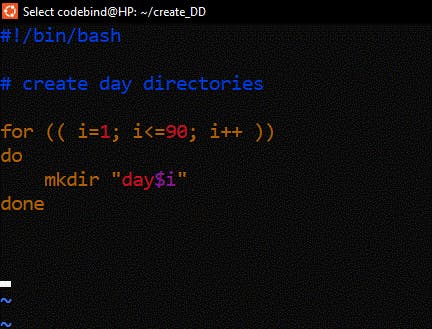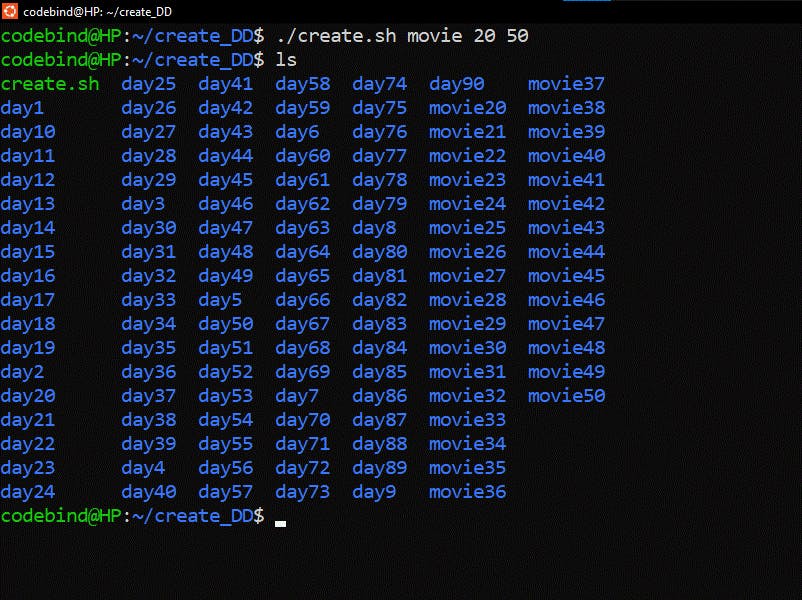Creating Multiple Directories, Taking Backup Using Shell Script, Cron and Crontab, and User Management - A Comprehensive Guide to Automation.
Create directories from Day 1 to Day 90


syntax:
The first part of the command "for (( i=1; i<=90; i++ ))" sets up a for loop that will run from 1 to 90.
The second part of the command "mkdir "day$i"" creates a new directory for each iteration of the loop and names it day followed by the loop's variable (i).
Once the loop is finished, Save the command in vim or nano whichever editor you are using.
After that give permission to the user to execute the file if needed by chmod command.
90 directories will have been created. By executing the shell script
Create additional directories along with the above shell script for 90days directories through Argument:


syntax
The arguments it takes are a prefix, a start number, and an end number.
The first argument it takes is a prefix. This is a string of characters that will appear in front of each directory name.
The second argument is the start number. This is the number that will start the range of directories being created.
The third argument is the end number. This is the number that will end the range of directories being created.
The loop begins with the start number and ends with the end number. For each number in the range, the loop creates a directory using the prefix and the current number in the loop.
When the loop is finished, all the directories in the range have been created.
How to take Backup by using shell script

syntax
This script will take a backup of the directory located at /home/codebind/script and store it in the directory /home/codebind/backup2.
The current date and time are stored in the variable curr_timestamp with the format of year-month-day-hour-minute-second.
The backup file is then stored in the target directory with the name of the timestamp plus the extension .tgz.
The script then checks if the source directory is not empty.
If the source directory is not empty, then it compresses the source directory to a .tgz file and stores it in the target directory.
Finally, the script prints out a message indicating that the backup is complete.
Use the command tar xf file_name to extract the file.
What are cron and crontab?
Cron is a scheduling utility in Unix-like operating systems (such as Linux) that allows you to schedule tasks to run automatically at specific times or intervals. These tasks can include running scripts, executing commands, or performing system maintenance tasks.
Crontab is a file that contains the list of scheduled tasks for cron to execute. The crontab file is usually located in the /etc/ directory or in a user's home directory. Each line in the crontab file specifies a task to be executed, along with the time and frequency at which it should be run.
To edit your crontab file, you can use the crontab command followed by the -e option to open the file in a text editor:
crontab -e
This will open the crontab file in the default text editor specified by the EDITOR environment variable.
If you want to view the contents of your crontab file without editing it, you can use the -l option:
crontab -l
This will display the contents of your crontab file in the terminal.
Note: that editing the crontab file requires basic knowledge of Unix commands and syntax. It's important to be careful when editing the crontab file, as errors can cause unintended consequences. It's also a good idea to test your scheduled tasks before deploying them to a production environment.
The five fields in the entry represent, in order:
Minute (0-59) Hour (0-23) Day of the month (1-31) Month (1-12) Day of the week (0-6, where 0 is Sunday)
* * * * * /path/to/my/script.sh
For example - You can specify any combination of values in each field to define a custom schedule. For example, if you want to run a script every Monday at 3:30 pm, you can use the following crontab entry:
30 15 * * 1 /path/to/my/script.sh
This entry specifies that the script should be executed at 3:30 pm every Monday (denoted by the value 1 in the fifth field).
In summary, cron is a scheduling utility and crontab is the file that contains the list of scheduled tasks for cron to execute. By editing the crontab file, you can schedule tasks to run automatically at specific times or intervals, allowing you to automate routine tasks and save time.
Using Crontab to backup:
Here I am using my above backup.sh shell script to execute crontab.


Use the command
tar xf file_nameto extract the file.Here home directory is in blue color is the extracted file of tar zip file with a timestamp in red color as shown in the above image.
About User Management
User management in Linux refers to the process of creating, modifying, and deleting user accounts on a Linux system. Here are some common user management tasks in Linux with their corresponding syntax using command-line tools:
- Creating a new user account: To create a new user account, use the useradd command with the desired username:
sudo useradd username
This will create a new user account with the default settings, including a home directory and a unique user ID.
- Modifying an existing user account: To modify an existing user account, use the usermod command with the desired options. For example, to change a user's password:
sudo usermod -p new_password username This will set the user's password to "new_password".
- Deleting a user account: To delete a user account, use the userdel command with the desired username:
sudo userdel username
This will remove the user's account and all associated files and settings from the system.
- Managing user groups: To manage user groups, use the
groupadd,groupmod, andgroupdelcommands. For example, to add a user to a group:
sudo usermod -aG groupname username
This will add the user to the specified group.
It is important to manage user accounts carefully to ensure the security and stability of the Linux system. You can learn more about user management and the various command-line tools available by consulting the Linux documentation or seeking out online tutorials and resources.
Thank you so much for taking the time to read my blog! Your support means the world to me, and I'm so grateful for your interest in my writing.
